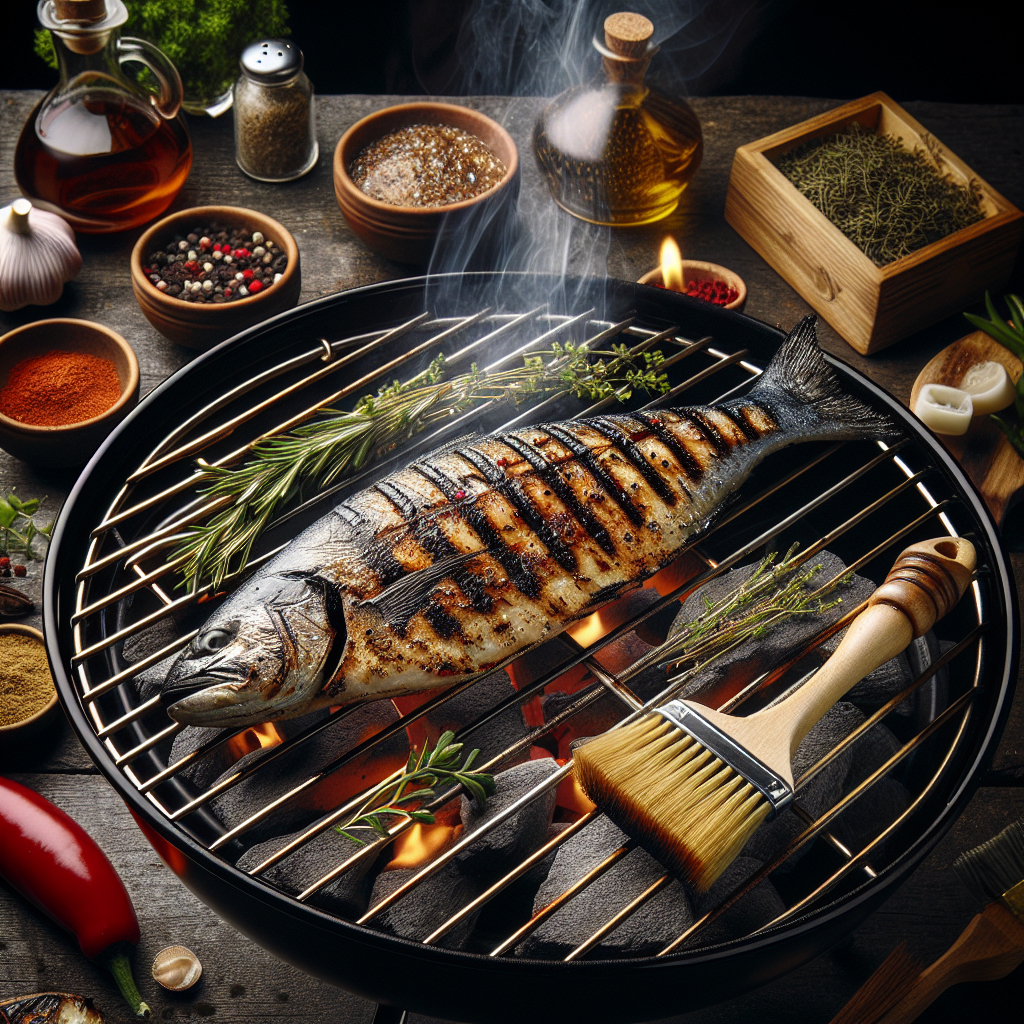Grilling fish can be a simple and delicious way to enjoy a healthy meal. Whether you’re a seasoned griller or just starting out, learning the art of grilling fish can elevate your culinary skills to new heights. From selecting the right type of fish to achieving the perfect level of doneness, this article will provide you with expert tips and techniques to ensure your fish turns out perfectly charred on the outside, tender and juicy on the inside. Get ready to impress your friends and family with your grilling prowess as we guide you through the process of grilling fish like a pro.

Preparing the Fish
Choosing the right fish
When it comes to grilling fish, choosing the right type of fish is crucial. Opt for fresh fish that is firm, such as salmon, trout, snapper, or grouper. These types of fish hold up well on the grill and retain their flavor.
Cleaning and gutting the fish
To ensure your fish is clean and ready for grilling, start by rinsing it under cold water. Removing the scales is also important in providing a pleasant texture and taste. Use a knife or a scaler to gently scrape the scales from the fish. After scaling, gut the fish by making a small incision near the head, then gently scrape out the innards.
Scaling the fish
Scaling the fish is an important step to ensure a smooth and delicious grilled fish. As mentioned earlier, use a scaler or a knife to gently remove the scales. Work from the tail towards the head, making sure to cover every inch of the fish to achieve an even result.
Removing the bones
Removing the bones from the fish is crucial to avoid any unpleasant surprises while enjoying your grilled masterpiece. Once the fish is cleaned and scaled, carefully run your fingers along the center of the fillet or use tweezers to remove any bones. Take your time to ensure the fish is bone-free and safe to eat.
Marinating and Seasoning the Fish
Selecting a marinade
Marinating fish not only enhances its flavor but also helps to keep it tender and moist while grilling. You can choose from a variety of marinades such as citrus-based, teriyaki, or herb-infused marinades. Consider the type of fish and your personal preferences when selecting a marinade.
Applying the marinade
Once you have selected a marinade, generously coat the fish with it. Make sure to evenly distribute the marinade over all sides of the fish, allowing it to penetrate the flesh. Place the marinated fish in a sealable plastic bag or a covered dish, and refrigerate it for at least 30 minutes, or up to overnight, for the flavors to develop.
Adding seasoning
Apart from the marinade, you can also add seasoning to further enhance the flavor of your grilled fish. Common seasonings for fish include salt, pepper, garlic powder, paprika, and herbs like dill, thyme, or rosemary. Sprinkle the desired seasonings on both sides of the fish just before grilling.
Letting the fish marinate
After applying the marinade and seasonings, it is important to let the fish marinate for the recommended amount of time. This will allow the flavors to infuse into the fish and create a delicious taste. While waiting, keep the fish refrigerated to ensure freshness and food safety.
Preparing the Grill
Choosing the right grill
Selecting the right grill can greatly impact the outcome of your grilled fish. Whether you prefer a charcoal grill for that authentic smoky flavor or a gas grill for convenience, ensure that it is in good working condition. Consider the size of the grill to accommodate the fish and any additional ingredients you may be grilling alongside it.
Preheating the grill
Before placing the fish on the grill, it is essential to preheat it to the appropriate temperature. This will ensure even cooking and prevent the fish from sticking to the grates. Preheat the grill to medium-high heat, typically around 400°F (200°C), for optimal results.
Cleaning the grill grates
Clean grill grates are crucial to prevent the fish from sticking and ensure proper heat distribution. Start by scrubbing the grates with a grill brush to remove any leftover residue from previous cookouts. Dip a cloth in vegetable oil and carefully rub it across the grates to create a non-stick surface.
Preventing Fish from Sticking
Oil the grill grates
To prevent the fish from sticking to the grill, it is important to oil the grates before cooking. Dip a folded paper towel in cooking oil and use tongs to rub it on the grates. Make sure to oil both sides of the grates to create a non-stick surface for the fish.
Using aluminum foil
Another option to prevent fish from sticking is to use aluminum foil. Create a foil packet by placing the fish, along with any desired seasonings and marinades, on a large piece of foil. Fold the foil over the fish and tightly seal the edges. This method helps to lock in moisture and prevents sticking.
Using a fish basket
A fish basket is a convenient tool that can prevent fish from sticking and falling apart on the grill. Simply place the fish inside the basket, securing it with the clasp, and grill as usual. The basket allows for easy flipping and prevents the fish from sticking to the grates.
Using cedar planks
Grilling fish on cedar planks not only prevents sticking but also adds a delightful smoky flavor. Soak the cedar planks in water for at least an hour before grilling to prevent them from catching fire. Place the seasoned fish on the cedar plank and grill it directly on top of the plank for a delicious and easy grilling experience.

Grilling Techniques
Direct grilling
Direct grilling is a common technique that involves placing the fish directly over the heat source. This method is ideal for thinner fillets or small whole fish. Place the fish on the preheated grill and cook for a few minutes on each side, depending on the thickness and type of fish.
Indirect grilling
Indirect grilling is a slower-cooking method that is especially suitable for larger or thicker pieces of fish. In this technique, the fish is cooked next to, rather than directly over, the heat source. This allows for more even and gentle cooking. Place the fish on a cooler part of the grill and cover it with the lid to ensure thorough cooking.
Using a grill pan
A grill pan is a practical alternative if you prefer to cook fish indoors or if you don’t have access to an outdoor grill. Heat the grill pan over medium-high heat and lightly oil it. Place the fish on the grill pan and cook for a few minutes on each side until it reaches your desired level of doneness.
Using skewers or kebabs
Skewering fish or making kebabs is a versatile and fun way to grill fish. Thread bite-sized pieces of fish onto skewers, alternating with vegetables or other desired ingredients. This method allows for even cooking and easy handling on the grill. Grill the skewers or kebabs for a few minutes on each side until the fish is cooked through.
Grilling Time and Temperature
Determining grilling time
The grilling time depends on the thickness and type of fish you are grilling. As a general guideline, grill fish for about 4-6 minutes per ½ inch (1.27 cm) of thickness. Use a timer and monitor the fish closely to avoid overcooking.
Adjusting for fish thickness
Thicker cuts of fish will require longer cooking times, while thinner fillets or small whole fish will cook more quickly. Adjust the grilling time accordingly to ensure that the fish is cooked through but still moist and tender.
Ideal grilling temperatures
The ideal grilling temperature for fish is around 400°F (200°C). This allows for a balance between searing the fish and cooking it gently. Monitor the grill’s temperature using a thermometer, if available, to ensure consistent heat throughout the grilling process.
Grilling Different Types of Fish
Fatty fish
Fatty fish, such as salmon and mackerel, are well-suited for grilling due to their high oil content. This oil helps keep the fish moist and prevents it from drying out on the grill. The high heat of grilling also caramelizes the natural oils, enhancing the flavor.
Lean fish
Lean fish, such as tilapia or cod, require a little more attention to prevent them from drying out. Consider using marinades or basting them with oil or butter to add moisture and flavor. The indirect grilling method or grilling on cedar planks can also help retain moisture.
Whole fish
Grilling whole fish can be a showstopper and creates a stunning presentation. Whether it’s a snapper, trout, or sea bass, grilling whole fish requires a slightly longer cooking time. Ensure the fish is properly gutted and scaled, then follow the grilling techniques and temperature guidelines for the best results.
Fish fillets
Fish fillets are a popular choice for grilling as they cook quickly and can be easily seasoned and marinated. Consider placing the fillets in a foil packet or using a fish basket to prevent sticking. Grill the fillets until they are opaque and flake easily with a fork.
Monitoring and Flipping the Fish
Using a meat thermometer
To ensure your grilled fish is perfectly cooked, you can use a meat thermometer to monitor its internal temperature. Fish is cooked when it reaches an internal temperature of 145°F (63°C). Insert the thermometer into the thickest part of the fish without touching the bone for an accurate reading.
Checking for doneness
If you do not have a meat thermometer, you can check the doneness of the fish visually. The fish should be opaque and easily flake with a fork. Gently press the fish with a spatula – if it springs back without leaving an indentation, it is likely done.
Flipping the fish
When it’s time to flip the fish, use a spatula or tongs to gently lift and turn it over. Be careful not to force the fish as it may stick to the grill or break apart. If grilling whole fish, use two spatulas to carefully flip it without damaging the delicate flesh.
Adding Flavor and Moisture
Basting the fish
Basting the fish with marinade, oil, or melted butter while grilling can help add flavor and keep it moist. Use a basting brush to apply the liquid to the fish every few minutes, making sure to coat both sides. Basting also helps to create a beautiful, shiny glaze on the grilled fish.
Adding citrus slices
Adding citrus slices, such as lemon or lime, to the grill can infuse the fish with a fresh and tangy flavor. Place the slices directly on the grill grates or on top of the fish while grilling. The heat will release the citrus oils, imparting a delightful aroma and taste.
Using herbs and spices
Herbs and spices are a fantastic way to elevate the flavor of grilled fish. Sprinkle fresh or dried herbs, such as dill, thyme, or rosemary, over the fish before grilling. You can also add spices like paprika, garlic powder, or cayenne pepper to create a deliciously seasoned crust.
Using marinade for basting
If you have marinated the fish, reserve a portion of the marinade for basting. However, it is important to never reuse marinade that has come into contact with raw fish, as it can contain harmful bacteria. Instead, boil the marinade for a few minutes before using it as a basting liquid to ensure food safety.
Safety and Cleaning
Safe grilling practices
When grilling fish, it is essential to follow safe grilling practices to prevent any foodborne illnesses. Make sure to wash your hands thoroughly before and after handling raw fish. Keep raw fish separated from other foods to avoid cross-contamination. Additionally, ensure that the fish reaches the appropriate internal temperature for safe consumption.
Handling raw and cooked fish
To avoid cross-contamination, use separate utensils and plates for raw and cooked fish. After transferring the cooked fish to a clean plate, discard any leftover marinade that came into contact with the raw fish. Proper handling and storage of the fish throughout the grilling process are crucial for food safety.
Cleaning the grill
After the grilling adventure is complete, it’s time to clean the grill. Allow the grill to cool down slightly, then scrape off any leftover food debris from the grates using a grill brush. Wipe down the exterior of the grill with a damp cloth. For a more thorough cleaning, consider using a grill cleaner or grill-specific cleaning products. Regular cleaning and maintenance will ensure your grill stays in top shape for future grilling endeavors.
Grilling fish can be a rewarding and flavorful culinary experience. By following the steps outlined above, you will be on your way to grilling delicious fish that is moist, flavorful, and cooked to perfection. So fire up the grill, prep your favorite fish, and enjoy a mouthwatering meal that you can proudly say you grilled yourself!

